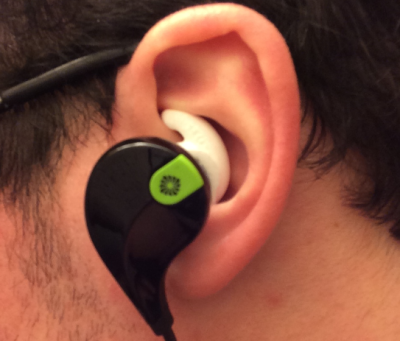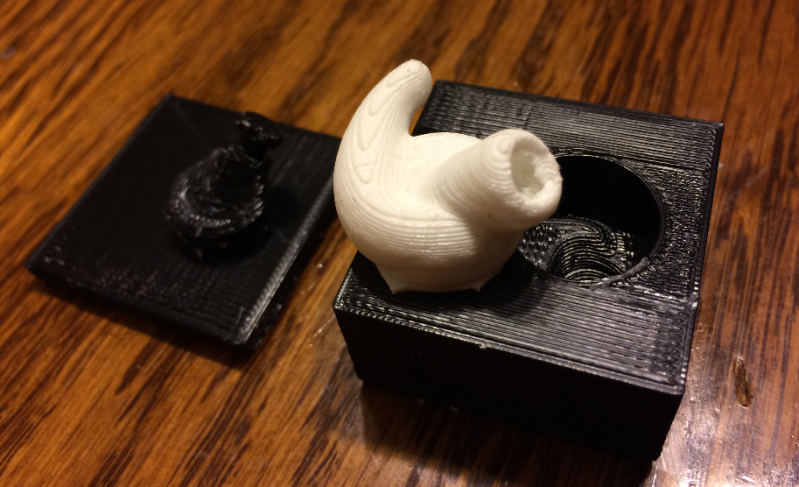Have you ever had a pair of ear buds fit perfectly out of the package? Probably not. Well, [Joe] decided to take matters into his own hands and cast his own silicone ear bud covers custom made for him.
The traditional route would have been to make an ear bud model, make a mold from it, cast a copy from it… etc, etc. But [Joe] wanted to try something else — he designed and 3D printed the two-part mold, and used plain old silicone caulking to fill it.
First he 3D modeled the ear bud covers in SolidWorks, then he had to learn how to design the mold for it, but luckily, there’s a handy tutorial. After printing the mold he opted to use 100% silicone caulking in order to make the part since he had some lying around the house. The problem is, this stuff can take days to cure — unless you mix in some cornstarch.

The golden ratio [Joe] found was about 5:1 silicone to cornstarch, which resulted in a cure time of about 20 minutes.
After curing you just need to trim off the excess silicone. In the molding process this is known as “flash”.
Since this is caulking he’s using, you’re going to want to wash off the part a few times because this type of silicone produces acetic acid as it cures.
The ear buds fit great and inspired [Joe] to try molding even more things, like a custom sleeping mask using the 3D scan of your own face!
















If you are going to use silicon why not cast your ear ?
Excuse my ignorance, but can you use potato starch? Stores don’t sell cornstarch here.
I imagine it would work fine. Give it a try. This mix is the same as Oogoo, a homemade version of Sugru
In Australia, UK and Europe we call corn starch corn flour. In the USA corn flour is something completely different. If you can make oobleck (non-neutonian fluid) with it, it’s the right stuff.
You might be talking rubbish, you can get cornstarch all over the place and I know for a fact they call it cornstarch in various countries on mainland europe, albeit often in their local language of course, but they use their word for corn and starch.
As for places where you can’t find it in the supermarket, they also sell it in places where they sell asian foodstuff, and middle-eastern foodstuff places.
Oh and on amazon and ebay too. Although you should be careful there since instead of selling it for around a quid like they should they peddle it off for up to 6 quid or more with some sellers.
No…there’s no such thing as “cornstarch” in Australia. Here it is called corn flour.
Canadian here, I’m so confused. You call the starches extracted from corn ‘corn flower’? Then what do you call the flour made from corn?
I certainly would never put silicone caulk inside my ear or anything in contact with my skin. They make specialized RTVs for things like this for a reason. Good prototype, Joe, but I would cast in a different material!
At least use a platinum curing silicone if it’s going to go into the body. Preferably food grade. Moisture cure acetic acid based silicones are unsuitable for this application though once they offgas it’s better than some of the alternatives.
How about a bake-out to accelerate the off-gassing of acetic acid?
It’s standard procedure for making conventional platinum-cure food-grade silicone molds to post-cure them at 100℃ for ~4 hours, so it might be advisable to do the same in this case in order to bake-out as much of the acetic acid as possible. Doing so under vacuum would likely be even more effective.
I personally can’t stand anything stuck in my ear, but I make an exception for ear plugs since I loathe loud/deafening noises even more, so this might also be a good way to make much more effective -and comfortable- earplugs (for noise… or swimming). And even if using silicone caulk is okay/safe for this application, I think I’ll stick with the platinum-cure food-grade silicone, too.
RTV silicone typically requires moisture to cure. Placing it in an oven may slow the process.
RTV stands for room temperature vulcanization. Which means it is intended to cure at room temperature. But most of them (all?) will be vastly accelerated by curing at a higher temperature (up to 350 or 400F in most cases).
You can get food-grade silicone in a caulking tube on Amazon nowadays. I don’t think it’s RTV, but it sure beats having to mix 2 ingredients (and it’s far cheaper than other platinum cure silicones). Obviously unsuitable for encasing electronics since heat curing will mess them up, but for things like earplugs it would be perfect.
Or he could just use GE’s silicone II, that doesn’t produce acetic acid as it cures.
Great, so instead of acetic acid, you instead have methyl alcohol and ammonia.
Yes. The ammonia is a gas. It goes away quickly. The Methanol washes off the part easily.
Justice_099 is right on the money. Industrial/residential silicone caulking compound probably uses acetic acid as it’s solvent to keep the silicone from curing. If you use it in a wearable prepare for skin irritation as a consequence of out-gassing. Silicone continues to cure for a long time after it stops being tacky.
Acetic acid probably no more corrosive than the mp3 files he will be playing, besides real men aren’t worried about a little vinegar in their ears from time to time. But seriously, nice hack with many other potential uses.
Yeah real men aren’t worried about anything cause we’re strong and dumb!
…and we don’t mind walking around smelling like a fish & chip shop.
So true and now we have Blurtooth multiplying the distortion.
If you are into haircuts the added square wave distortion will give the hair cells inside your ears a permanent haircut.
Only birds can regenerate the hair cells of hearing.
The hair cells involved with hearing are not exposed to the atmosphere.
Seriously spend the 30 bucks and buy some body safe silicone from smooth-on. Your ears will thank you, while you are at it download an iron maiden album or two.
Silicone mixed with cornstarch to help it cure is called ‘Oogoo’:
http://www.instructables.com/id/How-To-Make-Your-Own-Sugru-Substitute/
Even the 5:1 ratio comes form the instructable. It’s a neat trick, give the guy credit, and call it “Oogoo”.
So-called “neutral cure” RTV silicones that do not release acetic acid on cure are readily available at Home Despot and its ilk. Look for “Low Odor” varieties, like GE Silicone II. Not to say it’s any more sane to use these on skin, but they are far less objectionable to use.
:”Low odor” varieties are methyl alcohol and ammonia based instead of acetic acid. Still not a great idea.
Just squirt it straight into your ear.
That’ll give the ER staff something to talk about.
Squirt in some WD-40 first.
Like this?
http://www.youtube.com/watch?v=QmVFGypZm2g&t=1m46s
Exactly!
To ensure a complete fill w/ no voids, press the plunger slowly and gently until the insta-mold compound is seen coming out of the subjects nostrils. When cured, you can usually remove it with one good, hard yank; easy as can be! I can’t imagine why their test subject was looking at the syringe so apprehensively in the video…
I usually cringe when the bedwetters come out of the woodwork to warn about how dangerous something is, but there is no way in hell I’d put a random silicone blob in my ear on on my skin. Don’t forget your eardrum will be exposed to any vapors released by the plug. FDA approved or FDA “food grade” may only mean that it is safe for food to come in contact with a substance — not that it is safe to ingest the substance or that it is safe for a human to have long-term contact with the substance.
I desperately need a custom ear plug for a bluetooth headset. The above video prompted me to track down the company shown. They have a few DIY kits for $30-60. http://www.earinc.com/p1-nonelectronic-ez.php I had to laugh at how “uncomfortable” the lady in the video looked as they were preparing the syringe…
Why cringe? Clearly some of us are more concerned with others safety than they may be their-selves. I think it says alot about human nature to attempt to keep random strangers safe and sound over the internets.
I guess in theory you could source implant grade platinum curing silicones that are masterbatch tested if you are *really* concerned although 30 day limited implant grade is probably just as good. It’s not actually that expensive for such a small amount (if you can buy it in less than 5 gallon pails) but it’s all very high consistency stuff for the most part and therefore quite challenging to process with limited tools and methods. You *could* but then you would have to also consider that the cord that goes to your headphones is probably PVC, which means it contains probably 25% or more by weight of Phthalates, which touch your skin just as much and are absorbed through your skin. Oh and if they are cheap PVC headphones they also probably contain a fair bit of lead in the vinyl/PVC as well.
Along those same lines I made a parametric 3D printable mold for repairing TRS jacks. I used Sugru to cast the latest one and it came out really nice.
http://www.thingiverse.com/thing:653695
My motorcycle riding group had an event where someone came to make custom molded earplugs for $40/person. They put a tiny foam plug in your ear canal, coated your ear with mineral oil, then put the goop in your ear. After X minutes, they toook them out, maybe put some hardener on. You could use them after that.
For a bit more $$, they could embed earbuds. They would also make them for skeet shooters & other shooters. They could have a thing that let sound in until the bang, then it would auto “shut” to keep the sound out.
They’re very common. When my kids had ear tubes, the Dr. used the same tech to make swimming earplugs for them.
While I think what you’re doing is cool, I think you’re reinventing the material. You might be doing way more work then is required too. Having a repeatable fitting for the next set of earbuds is cool though.